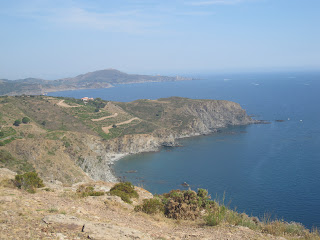 July 12
July 12We spent the day in the city of Avignon. This is a 45 minute drive from where we were staying in Beaumette. Avignon is not in the Luberon vallay, but it is still in Vaucluse, and is the capital of the Departement. The photo above is the famous pont d'Avignon from the French children's nursery rhyme. Actually this is what is left of it. It was built in the 1100's, but in the 1600's a huge flood took most of it out.
 Paulette and Claude took a walk on bridge.
Paulette and Claude took a walk on bridge. This is the other famous structure in Avignon, le Palais des Papes (Pope's Pallace). For various reasons Pope Clement V moved the papacy from Rome to Avignon in 1309. The pallace seen today was built in 1335 for the Popes and 8 Popes in all resided in Avignon. The Papacy was moved back to Rome in the early 1400's.
This is the other famous structure in Avignon, le Palais des Papes (Pope's Pallace). For various reasons Pope Clement V moved the papacy from Rome to Avignon in 1309. The pallace seen today was built in 1335 for the Popes and 8 Popes in all resided in Avignon. The Papacy was moved back to Rome in the early 1400's.
 Here we are looking from the ramparts at the view below.
Here we are looking from the ramparts at the view below. Here is one view looking out to a castle across the river.
Here is one view looking out to a castle across the river. This is a view looking down at part of the main town square.
This is a view looking down at part of the main town square. Avignon is the location for a major music, theatre and arts festival every summer. All these posters are advertising various acts you can take in. Because of this now famous and popular festival, Avignon is jammed with people in July. So much so that we had to park across the river and walk in. We had planned to stay until evening, but the crowds got the best of us and we left by mid afternoon.
Avignon is the location for a major music, theatre and arts festival every summer. All these posters are advertising various acts you can take in. Because of this now famous and popular festival, Avignon is jammed with people in July. So much so that we had to park across the river and walk in. We had planned to stay until evening, but the crowds got the best of us and we left by mid afternoon.
















































